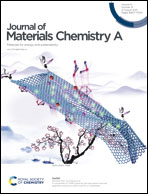Sacrificial species approach to designing robust transition metal phosphide cathodes for alkaline water electrolysis in discontinuous operation†
Abstract
The degradation of amorphous cobalt phosphides (CoPx) as an electrocatalyst for the hydrogen evolution reaction (HER) is studied in the discontinuous operation of alkaline water electrolysis cells (AWEs). Although amorphous CoPx shows a 100-fold enhancement in HER activity over nickel, the kinetic current for the HER is decreased after discontinuous operation. Under the off condition, the cathode potential of the AWE increases close to the equilibrium potential for CoPx oxidation to Co, Co(OH)2, CoOx, and CoPxOy. The irreversible oxide and hydroxide formation induces weaker interactions between Co and P, and thus the degradation of kinetics over CoPx, negatively affecting the HER even though a cathodic current is applied for recovery. A cathodic protection method is devised to mitigate the degradation of CoPx by shifting the electrode potential below the equilibrium potential of Co(OH)2. Mn is chosen as a sacrificial species, and it slows the rate of electrode degradation by negative polarization of the electrode. The results show that the co-deposition of even a small amount of Mn onto the CoPx electrode could limit the loss of HER activity during repeated discontinuous operation of the AWEs. Furthermore, in situ X-ray absorption near edge structure analysis confirms that the CoPx with co-deposited Mn does show the effect on holding the phase of CoPx during discontinuous operation.



 Please wait while we load your content...
Please wait while we load your content...